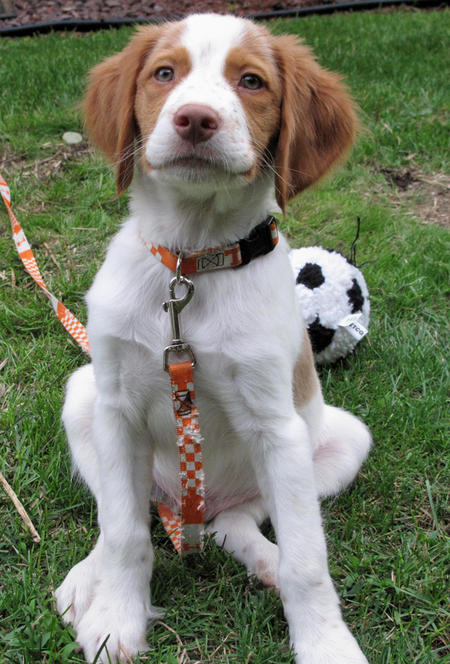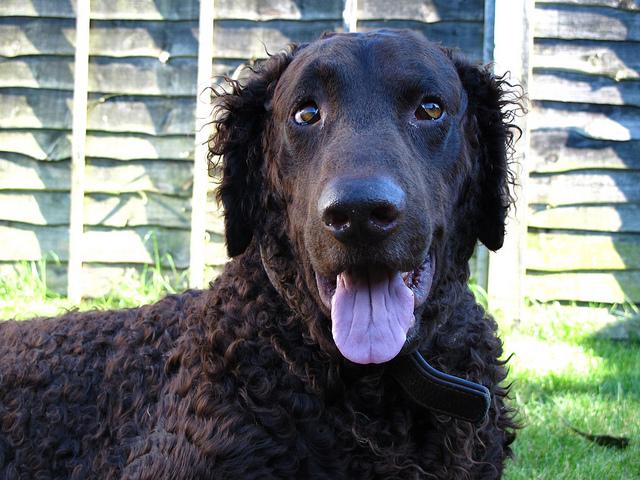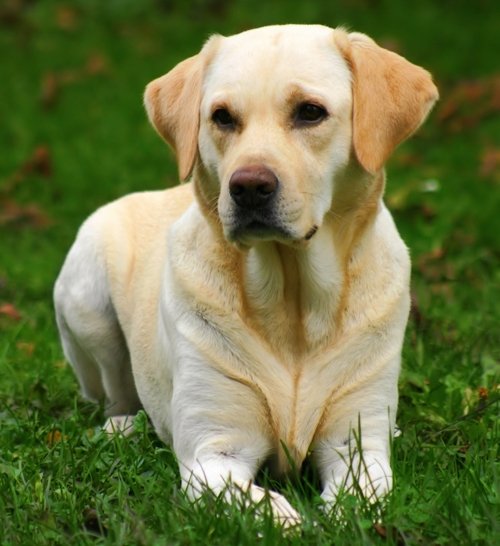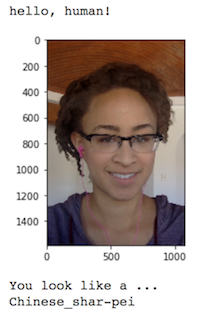Convolutional Neural Networks
import numpy as np
from glob import glob
# load filenames for human and dog images
human_files = np.array(glob("/data/lfw/*/*"))
dog_files = np.array(glob("/data/dog_images/*/*/*"))
# print number of images in each dataset
print('There are %d total human images.' % len(human_files))
print('There are %d total dog images.' % len(dog_files))
Step 1: Detect Humans
In this section, we use OpenCV's implementation of Haar feature-based cascade classifiers to detect human faces in images.
OpenCV provides many pre-trained face detectors, stored as XML files on github. We have downloaded one of these detectors and stored it in the haarcascades directory. In the next code cell, we demonstrate how to use this detector to find human faces in a sample image.
import cv2
import matplotlib.pyplot as plt
%matplotlib inline
# extract pre-trained face detector
face_cascade = cv2.CascadeClassifier('haarcascades/haarcascade_frontalface_alt.xml')
# load color (BGR) image
img = cv2.imread(human_files[0])
# convert BGR image to grayscale
gray = cv2.cvtColor(img, cv2.COLOR_BGR2GRAY)
# find faces in image
faces = face_cascade.detectMultiScale(gray)
# print number of faces detected in the image
print('Number of faces detected:', len(faces))
# get bounding box for each detected face
for (x,y,w,h) in faces:
# add bounding box to color image
cv2.rectangle(img,(x,y),(x+w,y+h),(255,0,0),2)
# convert BGR image to RGB for plotting
cv_rgb = cv2.cvtColor(img, cv2.COLOR_BGR2RGB)
# display the image, along with bounding box
plt.imshow(cv_rgb)
plt.show()
Before using any of the face detectors, it is standard procedure to convert the images to grayscale. The detectMultiScale function executes the classifier stored in face_cascade and takes the grayscale image as a parameter.
In the above code, faces is a numpy array of detected faces, where each row corresponds to a detected face. Each detected face is a 1D array with four entries that specifies the bounding box of the detected face. The first two entries in the array (extracted in the above code as x and y) specify the horizontal and vertical positions of the top left corner of the bounding box. The last two entries in the array (extracted here as w and h) specify the width and height of the box.
Write a Human Face Detector
We can use this procedure to write a function that returns True if a human face is detected in an image and False otherwise. This function, aptly named face_detector, takes a string-valued file path to an image as input and appears in the code block below.
# returns "True" if face is detected in image stored at img_path
def face_detector(img_path):
img = cv2.imread(img_path)
gray = cv2.cvtColor(img, cv2.COLOR_BGR2GRAY)
faces = face_cascade.detectMultiScale(gray)
return len(faces) > 0
(IMPLEMENTATION) Assess the Human Face Detector
Question 1: Use the code cell below to test the performance of the face_detector function.
- What percentage of the first 100 images in
human_fileshave a detected human face? - What percentage of the first 100 images in
dog_fileshave a detected human face?
Ideally, we would like 100% of human images with a detected face and 0% of dog images with a detected face. You will see that our algorithm falls short of this goal, but still gives acceptable performance. We extract the file paths for the first 100 images from each of the datasets and store them in the numpy arrays human_files_short and dog_files_short.
Answer: (You can print out your results and/or write your percentages in this cell)
Percentage of Human faces dectected in human_files: 98.0
Percentage of Human faces dectected in dog_files: 17.0
from tqdm import tqdm
human_files_short = human_files[:100]
dog_files_short = dog_files[:100]
#-#-# Do NOT modify the code above this line. #-#-#
## TODO: Test the performance of the face_detector algorithm
## on the images in human_files_short and dog_files_short.
human_count = 0
print("Dectecting human faces in human files")
for image in tqdm(human_files_short):
if face_detector(image):
human_count+=1
else:
# print("No human faces dectected")
pass
print("Dectecting human faces in dog files")
dog_count = 0
for image in tqdm(dog_files_short):
if face_detector(image):
dog_count+=1
else:
# print("No human faces dectected")
pass
print(" Percentage of Human faces dectected in human_files: ",human_count/len(human_files_short)*100)
print(" Percentage of Human faces dectected in human_files: ",dog_count/len(dog_files_short)*100)
We suggest the face detector from OpenCV as a potential way to detect human images in your algorithm, but you are free to explore other approaches, especially approaches that make use of deep learning :). Please use the code cell below to design and test your own face detection algorithm. If you decide to pursue this optional task, report performance on human_files_short and dog_files_short.
### (Optional)
### TODO: Test performance of anotherface detection algorithm.
### Feel free to use as many code cells as needed.### (Optional)
### TODO: Test performance of anotherface detection algorithm.
### Feel free to use as many code cells as needed.
eye_cascade = cv2.CascadeClassifier('haarcascades/haarcascade_eye.xml')
def face_detector_eye_img(img_path):
img = cv2.imread(img_path)
gray = cv2.cvtColor(img, cv2.COLOR_BGR2GRAY)
faces = face_cascade.detectMultiScale(gray)
for (x,y,w,h) in faces:
cv2.rectangle(img,(x,y),(x+w,y+h),(255,0,0),2)
roi_gray = gray[y:y+h, x:x+w]
roi_color = img[y:y+h, x:x+w]
eyes = eye_cascade.detectMultiScale(roi_gray)
print(len(eyes))
for (ex,ey,ew,eh) in eyes:
cv2.rectangle(roi_color,(ex,ey),(ex+ew,ey+eh),(0,255,0),2)
# convert BGR image to RGB for plotting
cv_rgb = cv2.cvtColor(img, cv2.COLOR_BGR2RGB)
# display the image, along with bounding box
plt.imshow(cv_rgb)
plt.show()
return len(faces) > 0 and len(eyes)>=1
face_detector_eye_img(human_files[2])
def face_detector_eye(img_path):
img = cv2.imread(img_path)
gray = cv2.cvtColor(img, cv2.COLOR_BGR2GRAY)
faces = face_cascade.detectMultiScale(gray)
for (x,y,w,h) in faces:
cv2.rectangle(img,(x,y),(x+w,y+h),(255,0,0),2)
roi_gray = gray[y:y+h, x:x+w]
roi_color = img[y:y+h, x:x+w]
eyes = eye_cascade.detectMultiScale(roi_gray)
for (ex,ey,ew,eh) in eyes:
cv2.rectangle(roi_color,(ex,ey),(ex+ew,ey+eh),(0,255,0),2)
# convert BGR image to RGB for plotting
cv_rgb = cv2.cvtColor(img, cv2.COLOR_BGR2RGB)
return len(faces) > 0 and len(eyes)>=1
from tqdm import tqdm
human_files_short = human_files[:100]
dog_files_short = dog_files[:100]
#-#-# Do NOT modify the code above this line. #-#-#
## TODO: Test the performance of the face_detector algorithm
## on the images in human_files_short and dog_files_short.
human_count = 0
print("Dectecting human faces in human files")
for image in tqdm(human_files_short):
if face_detector(image):
human_count+=1
else:
# print("No human faces dectected")
pass
print("Dectecting human faces in dog files")
dog_count = 0
for image in tqdm(dog_files_short):
if face_detector_eye(image):
dog_count+=1
else:
# print("No human faces dectected")
pass
print(" Percentage of Human faces dectected in human_files: ",human_count/len(human_files_short)*100)
print(" Percentage of Human faces dectected in human_files: ",dog_count/len(dog_files_short)*100)
Using eye_cascade for dog images reduced the percentage of Human faces dectected in dog_files from 17.0 to 6.0
Step 2: Detect Dogs
In this section, we use a pre-trained model to detect dogs in images.
Obtain Pre-trained VGG-16 Model
The code cell below downloads the VGG-16 model, along with weights that have been trained on ImageNet, a very large, very popular dataset used for image classification and other vision tasks. ImageNet contains over 10 million URLs, each linking to an image containing an object from one of 1000 categories.
import torch
import torchvision.models as models
# define VGG16 model
VGG16 = models.vgg16(pretrained=True)
# check if CUDA is available
use_cuda = torch.cuda.is_available()
# move model to GPU if CUDA is available
if use_cuda:
VGG16 = VGG16.cuda()
Given an image, this pre-trained VGG-16 model returns a prediction (derived from the 1000 possible categories in ImageNet) for the object that is contained in the image.
(IMPLEMENTATION) Making Predictions with a Pre-trained Model
In the next code cell, you will write a function that accepts a path to an image (such as 'dogImages/train/001.Affenpinscher/Affenpinscher_00001.jpg') as input and returns the index corresponding to the ImageNet class that is predicted by the pre-trained VGG-16 model. The output should always be an integer between 0 and 999, inclusive.
Before writing the function, make sure that you take the time to learn how to appropriately pre-process tensors for pre-trained models in the PyTorch documentation.
from PIL import Image
import torchvision.transforms as transforms
def VGG16_predict(img_path):
'''
Use pre-trained VGG-16 model to obtain index corresponding to
predicted ImageNet class for image at specified path
Args:
img_path: path to an image
Returns:
Index corresponding to VGG-16 model's prediction
'''
## TODO: Complete the function.
## Load and pre-process an image from the given img_path
## Return the *index* of the predicted class for that image
image = Image.open(img_path)
#VGG16 accept the shape (244, 244), so it resize to (244, 244)
transform_img = transforms.Compose([
transforms.Resize(size=(244, 244)),
transforms.ToTensor()])
image = transform_img(image)[:3,:,:].unsqueeze(0)
if use_cuda:
image = image.cuda()
ret = VGG16(image)
result = torch.max(ret,1)[1].item()
return result # predicted class index
VGG16_predict(human_files_short[1])
(IMPLEMENTATION) Write a Dog Detector
While looking at the dictionary, you will notice that the categories corresponding to dogs appear in an uninterrupted sequence and correspond to dictionary keys 151-268, inclusive, to include all categories from 'Chihuahua' to 'Mexican hairless'. Thus, in order to check to see if an image is predicted to contain a dog by the pre-trained VGG-16 model, we need only check if the pre-trained model predicts an index between 151 and 268 (inclusive).
Use these ideas to complete the dog_detector function below, which returns True if a dog is detected in an image (and False if not).
### returns "True" if a dog is detected in the image stored at img_path
def dog_detector(img_path):
## TODO: Complete the function.
if VGG16_predict(img_path)>=151 and VGG16_predict(img_path)<=268 :
return True
else:
return False # true/false
Answer:
### TODO: Test the performance of the dog_detector function
### on the images in human_files_short and dog_files_short.
human_count = 0
print("Dectecting dogs in human files")
for image in tqdm(human_files_short):
if dog_detector(image):
human_count+=1
print("Dectecting dogs in dog files")
dog_count = 0
for image in tqdm(dog_files_short):
if dog_detector(image):
dog_count+=1
print(" Percentage of dogs dectected in human_files: ",human_count/len(human_files_short)*100)
print(" Percentage of dogs dectected in dog_files: ",dog_count/len(dog_files_short)*100)
We suggest VGG-16 as a potential network to detect dog images in your algorithm, but you are free to explore other pre-trained networks (such as Inception-v3, ResNet-50, etc). Please use the code cell below to test other pre-trained PyTorch models. If you decide to pursue this optional task, report performance on human_files_short and dog_files_short.
### (Optional)
### TODO: Report the performance of another pre-trained network.
### Feel free to use as many code cells as needed.
Step 3: Create a CNN to Classify Dog Breeds (from Scratch)
Now that we have functions for detecting humans and dogs in images, we need a way to predict breed from images. In this step, you will create a CNN that classifies dog breeds. You must create your CNN from scratch (so, you can't use transfer learning yet!), and you must attain a test accuracy of at least 10%. In Step 4 of this notebook, you will have the opportunity to use transfer learning to create a CNN that attains greatly improved accuracy.
We mention that the task of assigning breed to dogs from images is considered exceptionally challenging. To see why, consider that even a human would have trouble distinguishing between a Brittany and a Welsh Springer Spaniel.
| Brittany | Welsh Springer Spaniel |
|---|---|

|
 |
It is not difficult to find other dog breed pairs with minimal inter-class variation (for instance, Curly-Coated Retrievers and American Water Spaniels).
| Curly-Coated Retriever | American Water Spaniel |
|---|---|

|
 |
Likewise, recall that labradors come in yellow, chocolate, and black. Your vision-based algorithm will have to conquer this high intra-class variation to determine how to classify all of these different shades as the same breed.
| Yellow Labrador | Chocolate Labrador | Black Labrador |
|---|---|---|

|
 |
 |
We also mention that random chance presents an exceptionally low bar: setting aside the fact that the classes are slightly imabalanced, a random guess will provide a correct answer roughly 1 in 133 times, which corresponds to an accuracy of less than 1%.
Remember that the practice is far ahead of the theory in deep learning. Experiment with many different architectures, and trust your intuition. And, of course, have fun!
(IMPLEMENTATION) Specify Data Loaders for the Dog Dataset
Use the code cell below to write three separate data loaders for the training, validation, and test datasets of dog images (located at dog_images/train, dog_images/valid, and dog_images/test, respectively). You may find this documentation on custom datasets to be a useful resource. If you are interested in augmenting your training and/or validation data, check out the wide variety of transforms!
### TODO: Write data loaders for training, validation, and test sets
## Specify appropriate transforms, and batch_sizes
import torch
import os
from torchvision import datasets,transforms
from torch import utils
from tqdm import tqdm
from PIL import ImageFile
use_cuda = torch.cuda.is_available()
ImageFile.LOAD_TRUNCATED_IMAGES = True
batch_size=20
data_transforms = {
'train' : transforms.Compose([
transforms.Resize(224),transforms.CenterCrop(224),
transforms.RandomHorizontalFlip(), # randomly flip and rotate
transforms.RandomRotation(10),
transforms.ToTensor(),
transforms.Normalize((0.5, 0.5, 0.5), (0.5, 0.5, 0.5))
]),
'valid' : transforms.Compose([
transforms.Resize(224),transforms.CenterCrop(224),
transforms.ToTensor(),
transforms.Normalize((0.5, 0.5, 0.5), (0.5, 0.5, 0.5))
]),
'test' : transforms.Compose([
transforms.Resize(224),transforms.CenterCrop(224),
transforms.ToTensor(),
transforms.Normalize((0.5, 0.5, 0.5), (0.5, 0.5, 0.5))
]),
}
train_dir = '/data/dog_images/train/'
valid_dir = '/data/dog_images/valid/'
test_dir = '/data/dog_images/test/'
image_datasets = {
'train' : datasets.ImageFolder(root=train_dir,transform=data_transforms['train']),
'valid' : datasets.ImageFolder(root=valid_dir,transform=data_transforms['valid']),
'test' : datasets.ImageFolder(root=test_dir,transform=data_transforms['test'])
}
# Loading Dataset
loaders_scratch = {
'train' : torch.utils.data.DataLoader(image_datasets['train'],batch_size = batch_size,shuffle=True),
'valid' : torch.utils.data.DataLoader(image_datasets['valid'],batch_size = batch_size),
'test' : torch.utils.data.DataLoader(image_datasets['test'],batch_size = batch_size)
}
Question 3: Describe your chosen procedure for preprocessing the data.
- How does your code resize the images (by cropping, stretching, etc)? What size did you pick for the input tensor, and why?
- Did you decide to augment the dataset? If so, how (through translations, flips, rotations, etc)? If not, why not?
Answer:
I have resized images to 256px and then cropped to 224 x 224, Lower size could be faster processing
Yes I augment the dataset, I have applied RandomRotation, RandomResizedCrop & RandomHorizontalFlip to add more training variations to the dataset
And no need of image augmentation for the validation test set
import torch.nn as nn
import torch.nn.functional as F
# define the CNN architecture
class Net(nn.Module):
### TODO: choose an architecture, and complete the class
def __init__(self):
super(Net, self).__init__()
## Define layers of a CNN
self.conv1 = nn.Conv2d(3,16,3,padding=1)
self.conv2 = nn.Conv2d(16,32,3,padding=1)
self.conv3 = nn.Conv2d(32,64,3,padding=1)
self.conv4 = nn.Conv2d(64,128,3,padding=1)
self.conv5 = nn.Conv2d(128,256,3,padding=1)
self.pool = nn.MaxPool2d(2,2)
self.fc1 = nn.Linear(12544,512)
self.fc2 = nn.Linear(512,133)
self.dropout = nn.Dropout(0.2)
self.conv_bn1 = nn.BatchNorm2d(3,16)
self.conv_bn2 = nn.BatchNorm2d(16)
self.conv_bn3 = nn.BatchNorm2d(32)
self.conv_bn4 = nn.BatchNorm2d(64)
self.conv_bn5 = nn.BatchNorm2d(128)
self.conv_bn6 = nn.BatchNorm2d(256)
def forward(self, x):
## Define forward behavior
x = self.pool(self.conv_bn2(F.relu(self.conv1(x))))
x = self.pool(self.conv_bn3(F.relu(self.conv2(x))))
x = self.pool(self.conv_bn4(F.relu(self.conv3(x))))
x = self.pool(self.conv_bn5(F.relu(self.conv4(x))))
x = self.pool(self.conv_bn6(F.relu(self.conv5(x))))
x = x.view(-1,256*7*7)
x = self.dropout(x)
x = F.relu(self.fc1(x))
x = self.dropout(x)
x = self.fc2(x)
return x
#-#-# You so NOT have to modify the code below this line. #-#-#
# instantiate the CNN
model_scratch = Net()
# move tensors to GPU if CUDA is available
if use_cuda:
model_scratch.cuda()
model_scratch
Question 4: Outline the steps you took to get to your final CNN architecture and your reasoning at each step.
Answer:
Net(
(conv1): Conv2d(3, 16, kernel_size=(3, 3), stride=(1, 1), padding=(1, 1))
(conv2): Conv2d(16, 32, kernel_size=(3, 3), stride=(1, 1), padding=(1, 1))
(conv3): Conv2d(32, 64, kernel_size=(3, 3), stride=(1, 1), padding=(1, 1))
(conv4): Conv2d(64, 128, kernel_size=(3, 3), stride=(1, 1), padding=(1, 1))
(conv5): Conv2d(128, 256, kernel_size=(3, 3), stride=(1, 1), padding=(1, 1))
(pool): MaxPool2d(kernel_size=2, stride=2, padding=0, dilation=1, ceil_mode=False)
(fc1): Linear(in_features=12544, out_features=512, bias=True)
(fc2): Linear(in_features=512, out_features=133, bias=True)
(dropout): Dropout(p=0.2)
(conv_bn1): BatchNorm2d(3, eps=16, momentum=0.1, affine=True, track_running_stats=True)
(conv_bn2): BatchNorm2d(16, eps=1e-05, momentum=0.1, affine=True, track_running_stats=True)
(conv_bn3): BatchNorm2d(32, eps=1e-05, momentum=0.1, affine=True, track_running_stats=True)
(conv_bn4): BatchNorm2d(64, eps=1e-05, momentum=0.1, affine=True, track_running_stats=True)
(conv_bn5): BatchNorm2d(128, eps=1e-05, momentum=0.1, affine=True, track_running_stats=True)
(conv_bn6): BatchNorm2d(256, eps=1e-05, momentum=0.1, affine=True, track_running_stats=True)
)I have created 5 Convolutional with Batch normalization, Batch normalization reduces the amount by what the hidden unit values shift around (covariance shift)
Max Pooling with Stride = 2
This CNN has two fully connected layers
applied Relu activation after the first fully connected layer
and finnaly I've applied dropout of 0.2 before each fully-connected layer to prevent overfitting
(IMPLEMENTATION) Specify Loss Function and Optimizer
Use the next code cell to specify a loss function and optimizer. Save the chosen loss function as criterion_scratch, and the optimizer as optimizer_scratch below.
import torch.optim as optim
import numpy as np
### TODO: select loss function
criterion_scratch = nn.CrossEntropyLoss()
### TODO: select optimizer
optimizer_scratch = torch.optim.Adam(model_scratch.parameters(),lr=0.001)
(IMPLEMENTATION) Train and Validate the Model
Train and validate your model in the code cell below. Save the final model parameters at filepath 'model_scratch.pt'.
def train(n_epochs, loaders, model, optimizer, criterion, use_cuda, save_path):
"""returns trained model"""
# initialize tracker for minimum validation loss
valid_loss_min = np.Inf
for epoch in tqdm(range(1, n_epochs+1)):
# initialize variables to monitor training and validation loss
train_loss = 0.0
valid_loss = 0.0
###################
# train the model #
###################
model.train()
for batch_idx, (data, target) in enumerate(loaders['train']):
# move to GPU
if use_cuda:
data, target = data.cuda(), target.cuda()
optimizer.zero_grad()
output = model(data)
loss = criterion(output,target)
loss.backward()
optimizer.step()
## find the loss and update the model parameters accordingly
## record the average training loss, using something like
train_loss = train_loss + ((1 / (batch_idx + 1)) * (loss.data - train_loss))
######################
# validate the model #
######################
model.eval()
for batch_idx, (data, target) in enumerate(loaders['valid']):
# move to GPU
if use_cuda:
data, target = data.cuda(), target.cuda()
## update the average validation loss
output = model(data)
loss = criterion(output,target)
valid_loss = valid_loss + ((1 / (batch_idx + 1)) * (loss.data - valid_loss))
print('Epoch: {} \tTraining Loss: {:.6f} \tValidation Loss: {:.6f}'.format(
epoch,
train_loss,
valid_loss
))
## TODO: save the model if validation loss has decreased
if valid_loss < valid_loss_min:
print('Validation loss decreased from ({:.6f} --> {:.6f}). Saving model ...'.format(
valid_loss_min,
valid_loss))
torch.save(model.state_dict(),save_path)
valid_loss_min = valid_loss
# return trained model
return model
# train the model
model_scratch = train(15, loaders_scratch, model_scratch, optimizer_scratch,
criterion_scratch, use_cuda, 'model_scratch.pt')
# load the model that got the best validation accuracy
model_scratch.load_state_dict(torch.load('model_scratch.pt'))
def test(loaders, model, criterion, use_cuda):
# monitor test loss and accuracy
test_loss = 0.
correct = 0.
total = 0.
model.eval()
for batch_idx, (data, target) in enumerate(loaders['test']):
# move to GPU
if use_cuda:
data, target = data.cuda(), target.cuda()
# forward pass: compute predicted outputs by passing inputs to the model
output = model(data)
# calculate the loss
loss = criterion(output, target)
# update average test loss
test_loss = test_loss + ((1 / (batch_idx + 1)) * (loss.data - test_loss))
# convert output probabilities to predicted class
pred = output.data.max(1, keepdim=True)[1]
# compare predictions to true label
correct += np.sum(np.squeeze(pred.eq(target.data.view_as(pred))).cpu().numpy())
total += data.size(0)
print('Test Loss: {:.6f}\n'.format(test_loss))
print('\nTest Accuracy: %2d%% (%2d/%2d)' % (
100. * correct / total, correct, total))
# call test function
test(loaders_scratch, model_scratch, criterion_scratch, use_cuda)
Step 4: Create a CNN to Classify Dog Breeds (using Transfer Learning)
You will now use transfer learning to create a CNN that can identify dog breed from images. Your CNN must attain at least 60% accuracy on the test set.
(IMPLEMENTATION) Specify Data Loaders for the Dog Dataset
Use the code cell below to write three separate data loaders for the training, validation, and test datasets of dog images (located at dogImages/train, dogImages/valid, and dogImages/test, respectively).
If you like, you are welcome to use the same data loaders from the previous step, when you created a CNN from scratch.
## TODO: Specify data loaders
num_workers = 0
batch_size = 128
normalize = transforms.Normalize(mean=[0.485, 0.456, 0.406], std=[0.229, 0.224, 0.225])
data_transfer = datasets.ImageFolder('/data/dog_images/train/', transforms.Compose([
transforms.Resize(256),
transforms.CenterCrop(224),
transforms.RandomHorizontalFlip(),
transforms.RandomRotation(10),
transforms.ToTensor(),
normalize,
]))
data_transfer = { 'train' : data_transfer}
train_loader = torch.utils.data.DataLoader(data_transfer['train'], batch_size=batch_size, num_workers=num_workers, shuffle=True)
valid_loader = torch.utils.data.DataLoader(
datasets.ImageFolder('/data/dog_images/valid', transforms.Compose([
transforms.Resize(256),
transforms.CenterCrop(224),
transforms.ToTensor(),
normalize,
])), batch_size=batch_size, num_workers=num_workers, shuffle=True)
test_loader = torch.utils.data.DataLoader(
datasets.ImageFolder('/data/dog_images/test', transforms.Compose([
transforms.Resize(256),
transforms.CenterCrop(224),
transforms.ToTensor(),
normalize,
])), batch_size=batch_size, num_workers=num_workers, shuffle=True)
loaders_transfer = {'train': train_loader, 'test': test_loader, 'valid' : valid_loader}
import torchvision.models as models
import torch.nn as nn
## TODO: Specify model architecture
model_transfer = models.vgg16(pretrained=True)
for param in model_transfer.features.parameters():
param.requires_grad = False
n_inputs = model_transfer.classifier[6].in_features
last_layer = nn.Linear(n_inputs, 133)
model_transfer.classifier[6] = last_layer
if use_cuda:
model_transfer = model_transfer.cuda()
model_transfer
Question 5: Outline the steps you took to get to your final CNN architecture and your reasoning at each step. Describe why you think the architecture is suitable for the current problem.
Answer:
VVG was trained on all different images which includes different types of dogs
I have made changes to classification module to match the classes in our dataset (133)
In the final Fully connected layer like doen in the class
(IMPLEMENTATION) Specify Loss Function and Optimizer
Use the next code cell to specify a loss function and optimizer. Save the chosen loss function as criterion_transfer, and the optimizer as optimizer_transfer below.
criterion_transfer = nn.CrossEntropyLoss()
optimizer_transfer = optim.Adam(model_transfer.classifier.parameters(), lr=0.001)
(IMPLEMENTATION) Train and Validate the Model
Train and validate your model in the code cell below. Save the final model parameters at filepath 'model_transfer.pt'.
# train the model
model_transfer = train(15, loaders_transfer, model_transfer, optimizer_transfer, criterion_transfer, use_cuda, 'model_transfer.pt')
# load the model that got the best validation accuracy (uncomment the line below)
model_transfer.load_state_dict(torch.load('model_transfer.pt'))
test(loaders_transfer, model_transfer, criterion_transfer, use_cuda)
### TODO: Write a function that takes a path to an image as input
### and returns the dog breed that is predicted by the model.
# list of class names by index, i.e. a name can be accessed like class_names[0]
class_names = [item[4:].replace("_", " ") for item in data_transfer['train'].classes]
# Load the trained model 'model_transfer.pt'
model_transfer.load_state_dict(torch.load('model_transfer.pt', map_location='cpu'))
def predict_breed_transfer(img_path):
# load the image and return the predicted breed
image = Image.open(img_path).convert('RGB')
prediction_transform = transforms.Compose([transforms.Resize(size=(224, 224)),
transforms.ToTensor(),
transforms.Normalize(mean=[0.485, 0.456, 0.406], std=[0.229, 0.224, 0.225])])
# discard the transparent, alpha channel (that's the :3) and add the batch dimension
image = prediction_transform(image)[:3,:,:].unsqueeze(0)
image = image.cuda()
model_transfer.eval()
index = torch.argmax(model_transfer(image))
return class_names[index]
Step 5: Write your Algorithm
Write an algorithm that accepts a file path to an image and first determines whether the image contains a human, dog, or neither. Then,
- if a dog is detected in the image, return the predicted breed.
- if a human is detected in the image, return the resembling dog breed.
- if neither is detected in the image, provide output that indicates an error.
You are welcome to write your own functions for detecting humans and dogs in images, but feel free to use the face_detector and human_detector functions developed above. You are required to use your CNN from Step 4 to predict dog breed.
Some sample output for our algorithm is provided below, but feel free to design your own user experience!

(IMPLEMENTATION) Write your Algorithm
### TODO: Write your algorithm.
### Feel free to use as many code cells as needed.
def run_app(img_path):
## handle cases for a human face, dog, and neither
if dog_detector(img_path) is True:
breed = predict_breed_transfer(img_path)
print("Hello Dog")
img = Image.open(img_path)
plt.imshow(img)
plt.show()
print(" Your breed is {}\n".format(breed))
elif face_detector(img_path) > 0:
breed = predict_breed_transfer(img_path)
print("Hello Human")
img = Image.open(img_path)
plt.imshow(img)
plt.show()
print("You look like a {0}\n".format(breed))
else:
print("Not a Human or Dog\n")
Step 6: Test Your Algorithm
In this section, you will take your new algorithm for a spin! What kind of dog does the algorithm think that you look like? If you have a dog, does it predict your dog's breed accurately? If you have a cat, does it mistakenly think that your cat is a dog?
(IMPLEMENTATION) Test Your Algorithm on Sample Images!
Test your algorithm at least six images on your computer. Feel free to use any images you like. Use at least two human and two dog images.
Question 6: Is the output better than you expected :) ? Or worse :( ? Provide at least three possible points of improvement for your algorithm.
Answer: My output is better then i expected : )
(Three possible points for improvement)
Using more training data
Fine tuning the model to get a better accuracy
Using different optimizers and loss functions
More Augmentation during training(rotating and fliping images)
## TODO: Execute your algorithm from Step 6 on
## at least 6 images on your computer.
## Feel free to use as many code cells as needed.
## suggested code, below
for file in np.hstack((human_files[:3], dog_files[:3])):
run_app(file)
run_app('./my_images/dog2.jpg')
run_app('./my_images/mygit.jpeg')
run_app('./my_images/cat.jpeg')
run_app('./my_images/dog.jpg')
run_app('./my_images/mypic.jpeg')
run_app('./my_images/dog3.png')